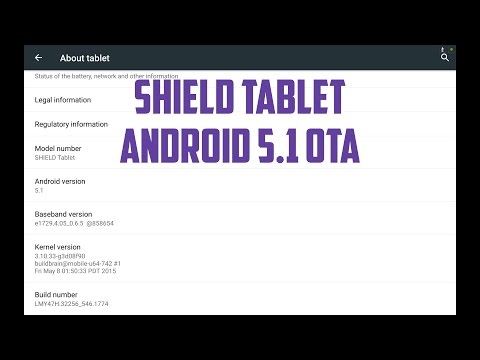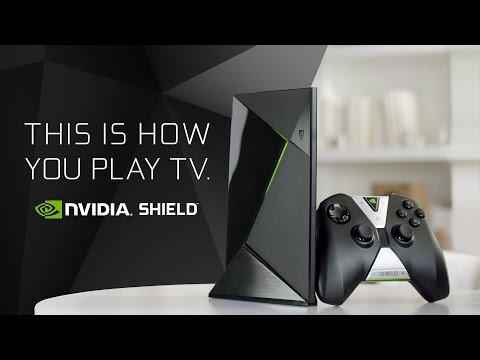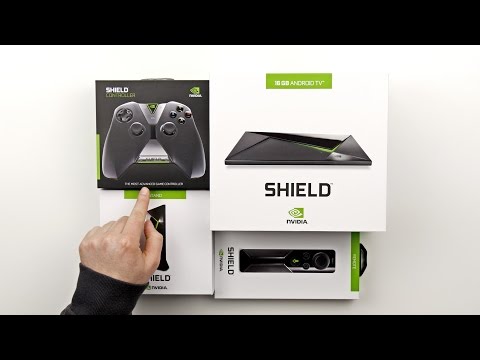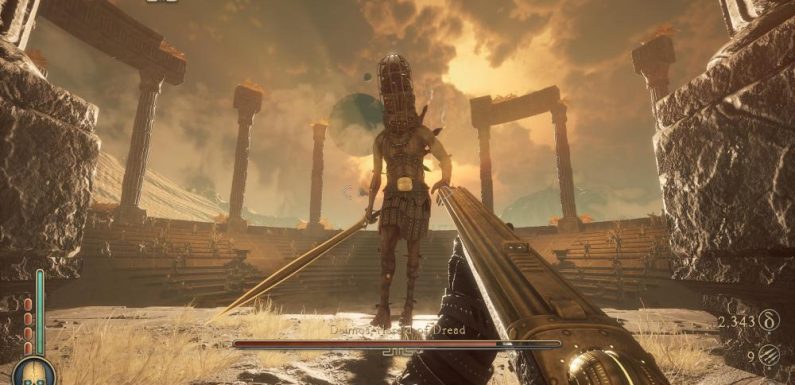
There
are
a
lot
of
cheap
controllers
on
the
market
these
days,
all
vying
for
your
attention.
Very
few
of
them
are
actually
any
good
and
trying
to
sort
through
the
chaff
to
find
one
that’s
actually
good
value
for
the
money
is
tricky.
This
is
why
we’re
going
to
check
out
Binbok
Gemini,
a
controller
from
the
Chinese
company
Binbok
which
promises
a
lot
for
a
relatively
small
price
tag
of
$39.99.
How
does
it
compare
to
the
more
expensive
but
reliable
Nintendo
Switch
Pro
Controller?
Let’s
find
out.
Let’s
start
with
the
most
obvious
thing:
the
looks.
The
Gemini
comes
in
either
white
or
black,
both
featuring
clear
pieces
of
plastic
so
that
the
innards
can
be
seen.
The
white
version
boasts
some
powder-blue
and
powder-pink
buttons,
whereas
the
black
one
is
a
tad
more
subdued.
And,
of
course,
both
have
strong
LED
lights
that
can
have
their
output
turned
up
and
down,
or
even
turned
off
entirely.
White
or
black,
both
have
a
distinctive
and
striking
style
that’s
likely
cause
to
divide
opinions.
They
have
an
old-school
MadCatz
vibe,
the
aesthetic
you
expect
from
the
off-brand
controllers
your
mates
would
have
lying
around
for
when
people
would
drop
by.
The
LED
lighting
has
a
handful
of
colour
settings
or
you
can
turn
it
off
entirely,
which
is
my
preference.
Without
the
lights,
the
black
version
looks
pretty
sweet.
The
white
one
is
much
more
garish,
obviously,
but
I
kind
of
like
the
white
plastic
shell
combined
with
the
blue
and
pink
buttons.
It
looks
more
like
a
toy
controller
you’d
be
a
child,
and
I’m
here
for
it.
Works
on:
Switch,
PC
Reviewed
On:
Switch,
PC
Made
By:
Binbok
Price:
$39.99Controllers
provided
by
Binbok
for
review.
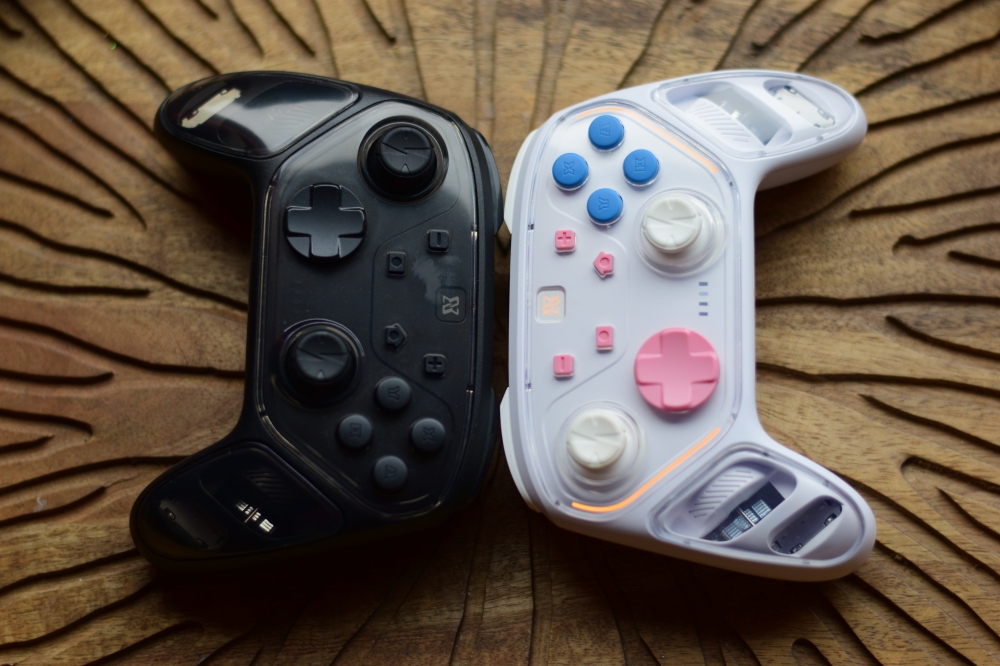
Advertisements
The
Nintendo
Switch
Pro
Controller
is
obviously
the
defining
Switch
controller,
and
for
good
reason:
it’s
comfy
as
shit!
It’s
hardly
surprising
that
the
Gemini
is
heavily
based
on
that
design.
The
only
difference
I
noticed
is
that
the
Gemini
flares
out
a
teeny
bit
more
on
the
handles.
It’s
a
small
change,
but
enough
of
one
to
make
me
favour
the
Switch
Pro
Controller.
With
that
said,
imitation
is
the
sincerest
form
of
flattery,
and
in
this
case,
it’s
imitating
one
of
the
most
comfortable
controllers
ever
made.
That
makes
the
Gemini
pretty
damn
nice
to
hold,
too.
The
build
quality
isn’t
quite
as
good
as
the
real
thing,
mind
you.
There’s
nothing
too
egregious:
the
shell
feels
solid
and
nice
to
hold
and
the
weight
is
the
same
as
the
Pro
Controller,
giving
it
a
good
sense
of
heft.
The
buttons
are
a
cheaper
feeling
yet
still
have
a
satisfying
action,
one
that
takes
more
pressure
than
something
like
the
Pro
Controller
or
an
Xbox
pad.
Speaking
of
Xbox,
the
d-pad
on
the
Gemini
feels
quite
similar
to
the
Xbox
in
terms
of
its
clickiness
and
movement.
In
other
words,
it’s
decent,
but
nothing
amazing.
One
area
where
the
Gemini
beats
out
the
Pro
Controller
and
equals
the
8BitDo
I
reviewed,
is
the
use
of
Hall
Effect
joysticks.
If
you
aren’t
aware
of
what
those
are,
Hall
Effect
sticks
use
magnets
and
conductors
to
detect
inputs
rather
than
the
traditional
potentiometer.
There
are
many
claims
about
whether
Hall
Effect
sticks
are
superior
in
every
way
or
just
in
certain
ones.
Generally
speaking,
they
do
tend
to
be
smoother,
more
accurate
and
have
fewer
dead
zones
but
it
depends
on
the
quality
of
the
components.
The
one
thing
we
can
say
with
certainty
is
that
Hall
Effect
sticks
are
more
durable
and
far
less
likely
to
suffer
from
drifting
issues,
the
very
same
problem
that
plagues
the
Nintendo
Switch
Joycons.
Overall,
the
sticks
felt
smooth
and
precise.
My
only
gripe,
a
very
small
one,
is
the
slightly
rough
feeling
when
the
sticks
rub
against
the
circumference.
It’s
a
minute
detail
that
doesn’t
ultimately
damage
the
Gemini’s
performance
but
does
speak
to
its
budget
nature.
Other
than
that,
I
never
had
a
problem
with
them
and
felt
content
with
their
performance.
Of
course,
I’m
not
out
there
competing
at
the
highest
levels
of
multiplayer
mayhem
where
even
the
slightest
hiccup
can
spell
disaster.
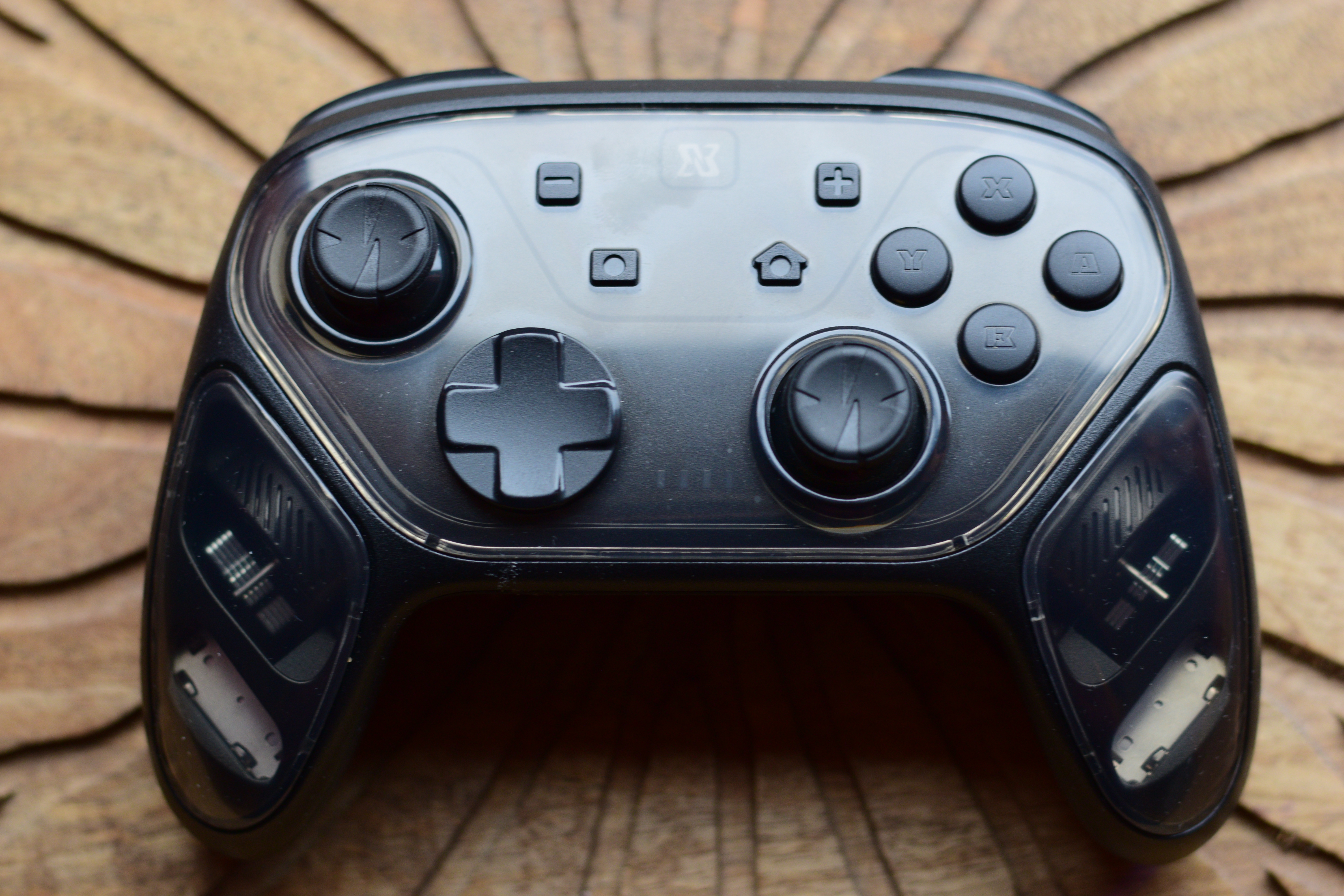

official
Switch
Pro
Controller
vs
the
Binbok
Gemini
Two
special
macro
buttons
are
hidden
on
the
rear
of
the
Gemini,
just
waiting
for
your
probing
fingers
to
find
them.
Their
location
is
judged
perfectly,
at
least
for
my
hands,
so
that
they
fall
right
under
where
my
middle
fingers
naturally
rest.
Recording
a
series
of
commands
is
easy,
and
the
controller
allows
a
maximum
of
21
inputs
per
macro
and
will
even
remember
the
timing
of
your
presses.
Of
course,
how
useful
this
feature
is
will
vary
wildly
from
player
to
player.
Personally,
I
immediately
thought
of
how
useful
it
could
be
on
Helldivers
2,
since
I
often
like
to
kick
back
with
a
controller
for
some
bug-slaughtering.
It
worked
pretty
well,
though
I
did
note
that
Windows
detects
the
Gemini
as
a
Switch
Pro
Controller
which
can
cause
a
few
issues
with
button
layouts
and
the
like.
It’s
probably
not
going
to
be
a
problem
for
most
people,
but
still
worth
mentioning.
The
rear
also
has
a
few
more
buttons
worth
discussing.
There’s
a
turbo
function,
which
will
make
a
button
act
like
you’re
repeatedly
pressing
it
while
you
hold
it
down.
For
example,
in
a
fighting
game
instead
of
mashing
the
punch
button,
you
can
just
hold
it
and
the
game
will
register
it
as
separate
button
presses.
Features
like
this
can
be
controversial,
especially
in
the
fighting
game
scene
or
in
any
competitive
online
scene,
so
always
be
careful
about
using
them.
For
myself,
I
find
it
useful
in
FPS
games
because
repeatedly
pulling
the
trigger
can
exacerbate
some
finger
and
wrist
issues
I
have.
I
did
find
myself
accidentally
activating
the
turbo
button
without
meaning
to.
It
doesn’t
take
a
lot
of
pressure
to
activate
it,
so
if
your
fingers
wander
a
little
it’s
possible
to
catch
the
button.
This
happened
to
me
in
Marion
Kart
8
when
my
acceleration
seemed
to
stop
working
properly.
It
took
me
a
minute
to
figure
out
what
had
happened.
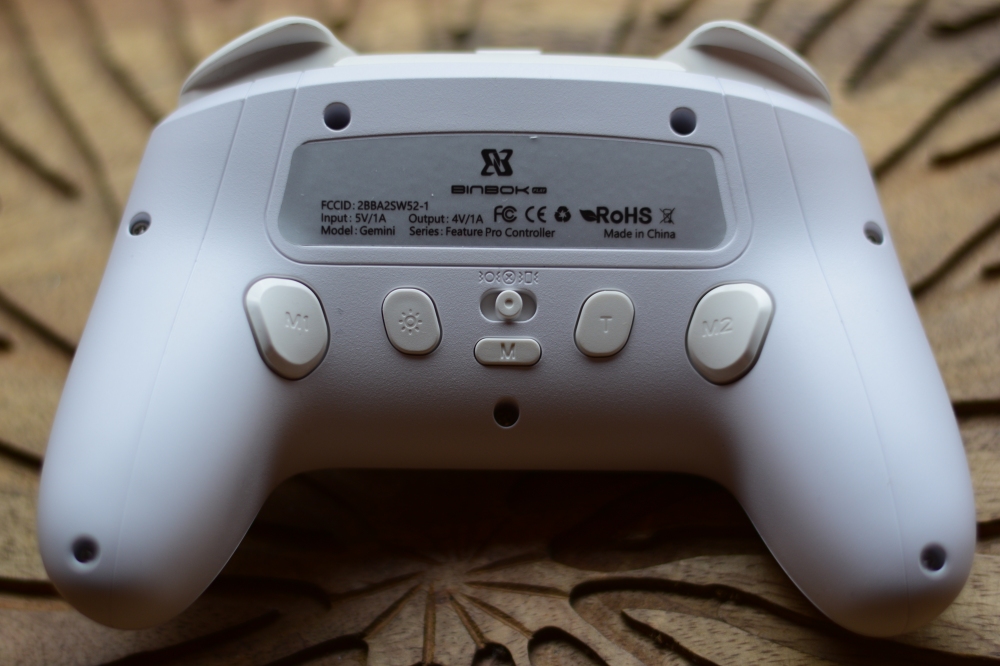
The
lighting
button
is
also
located
on
the
back
of
the
Gemini,
easily
letting
you
swap
between
colours
and
special
modes.
There
are
three
modes
in
total
(single
colour
breathing,
automatic
colour
breathing
and
solid
single
colour)
and
the
brightness
can
be
set
to
40%,
70%,
100%
or
off
entirely.
I’ve
said
it
before
and
I’ll
say
it
again:
I’m
a
sucker
for
some
nice
RGB.
A
slider
that
switches
between
two
vibration
modes
is
located
at
the
halfway
point
on
the
back
of
the
Gemini.
The
first
is
the
classic
linear
rumble
that
you’ll
find
in
almost
every
controller
on
the
market.
Thanks
to
the
transparent
casing
you
can
see
the
two
motors
fire
up
on
the
controller’s
arms
which
is
pretty
cool.
It
has
some
decent
strength
and
an
acceptable
level
of
detail
in
how
it
matches
up
with
the
on-screen
action,
although
it
can
obviously
depend
heavily
on
the
game
you
are
playing.
The
other
vibration
method
fires
up
a
motor
somewhere
in
the
middle
of
the
Gemini’s
body
and
it’s
a
much
weaker
type,
more
like
a
high-pitched
buzz
than
the
low-down
rumble
of
the
linear
motors.
I
tended
to
avoid
the
second
type
mostly
because
of
the
noise
it
can
make
being
obnoxious.
You
can
also
choose
to
turn
off
the
vibration
completely.
Finally,
we
get
gyro
control
as
well,
a
requirement
in
a
handful
of
Switch
games.
Overall,
the
official
Pro
Controller
is
stronger
in
this
area.
It’s
a
bit
more
accurate.
The
Gemini
comes
close
though,
and
is
definitely
good
enough
for
general
use
if
that’s
your
wobbly
cup
of
tea.
Amiibo
support
on
3rd
party
controllers
is
a
rarity
and
the
Gemini
does
not
buck
that
trend,
sadly.
I
imagine
it’s
because
being
able
to
scan
Amiibo’s
is
a
relatively
niche
feature
so
companies
don’t
see
the
point
in
spending
money
to
include
it.

Before
I
finish
this
review,
I
want
to
talk
about
quality
assurance.
Even
with
two
controllers,
I
can’t
judge
how
well-constructed
products
actually
are
on
a
large
scale,
which
is
why
I
always
try
to
look
at
experiences
actual
customers
have
as
well.
With
the
Gemini,
that’s
a
limited
pool
because
there
are
not
too
many
people
talking
about
it.
However,
I
did
want
to
point
out
that
the
Amazon
reviews
for
the
Gemini
highlight
some
potential
issues
to
be
aware
of,
such
dead
zones
and
the
joysticks
getting
stuck.
Other
reviews
are
glowing
and
find
it
comparable
to
the
Pro
Controller.
The
good
news
is
that
Binbok
seems
open
to
replacing
the
controller
if
there
are
issues.
Aaaaaaaaand
that
brings
me
barrelling
toward
the
conclusion
of
my
own
review
like
a
runaway
train
being
driven
by
a
suicidal
Mario.
Honestly,
I
don’t
know
where
I’m
going
with
this
analogy.
The
point
is,
that
the
Binbok
Gemini
is
an
impressive
controller
at
an
equally
impressive
price.
The
Pro
Controller
remains
the
superior
option
overall,
being
of
slightly
better
quality
and
boasting
a
nicer
overall
feel
in
its
buttons
and
stuck,
but
it’s
also
the
pricier
choice.
The
Gemini
is
perfect
for
adding
some
extra
controllers
to
your
armoury
without
breaking
the
bank
but
is
also
worth
it
as
a
primary
controller,
a
budget-conscious
replacement
for
the
official
Nintendo
Switch
Pro
Controller.




